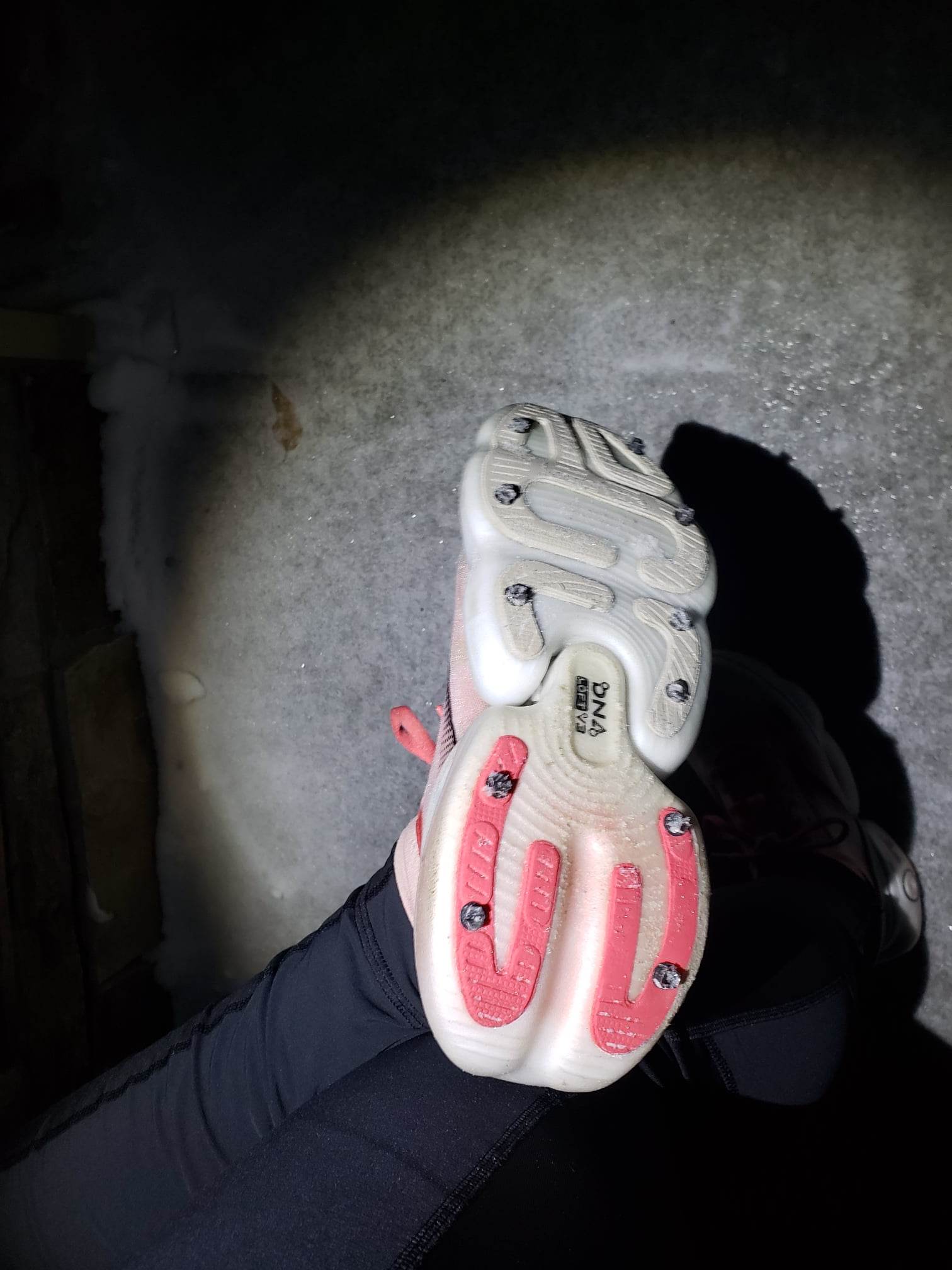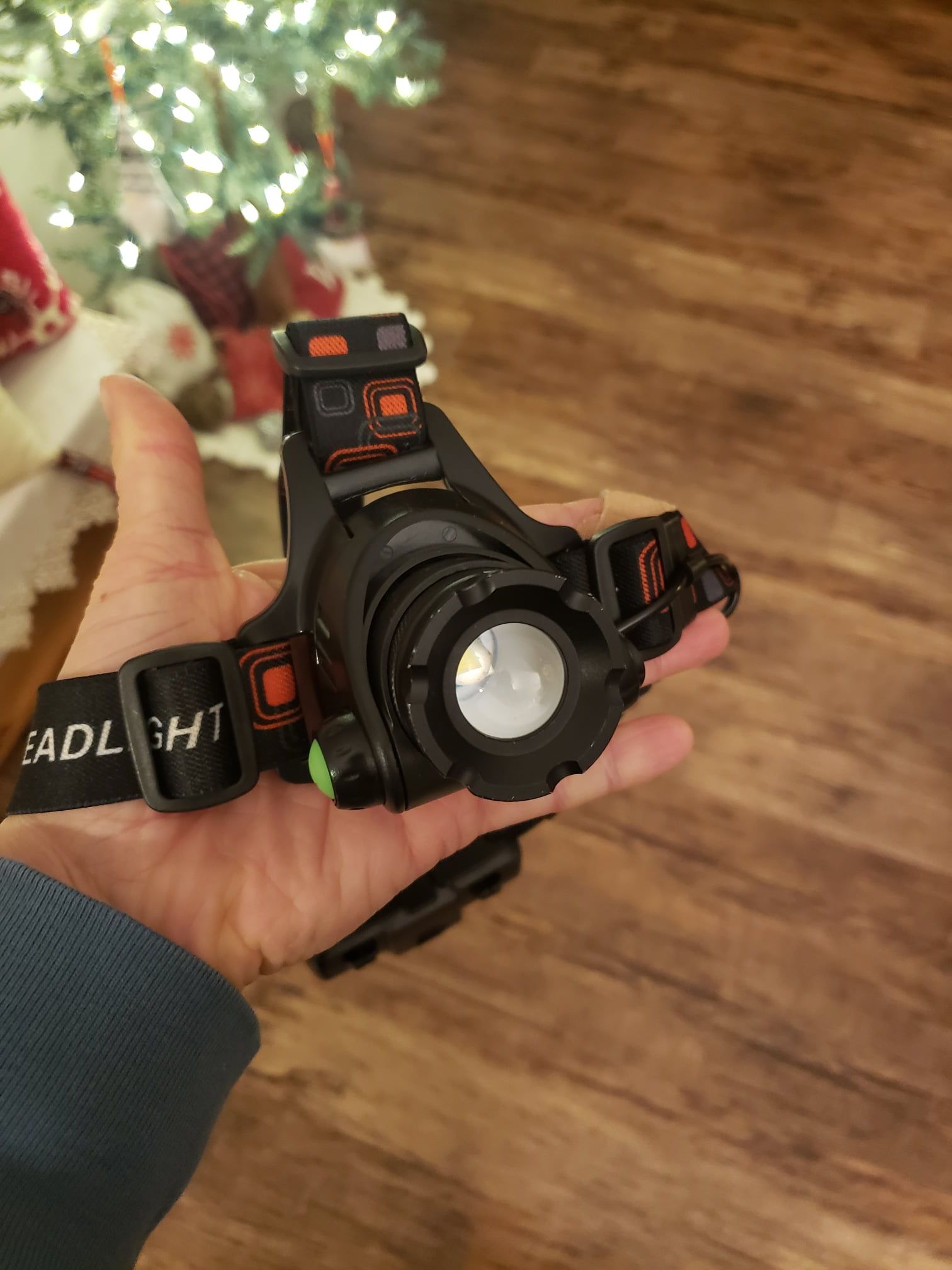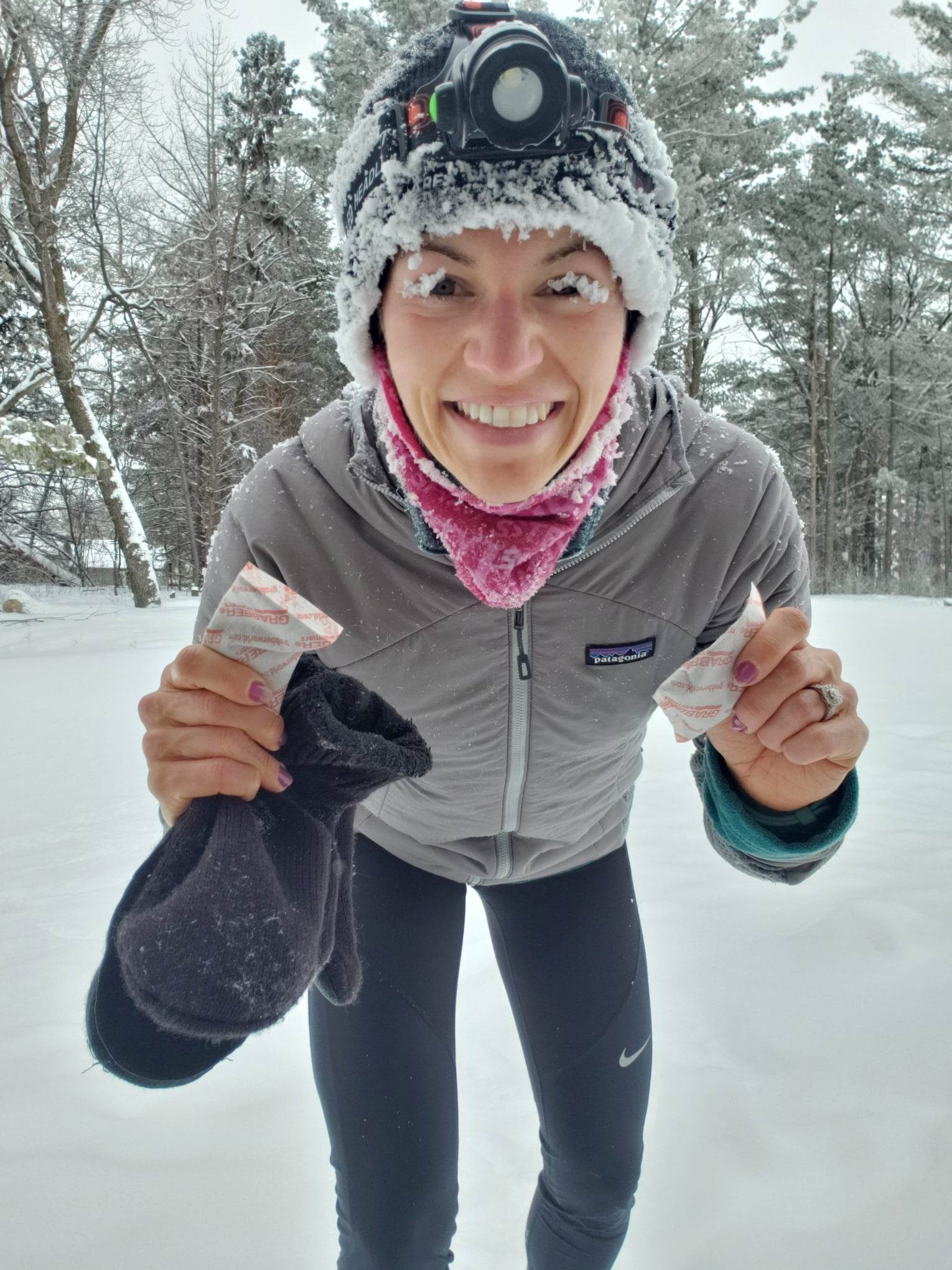want to love winter running? maybe you want to NOT hate it?
EVERYTHING
COLD WEATHER RUNNING
Please know that you are NOT any less of a runner for using the treadmill or waiting for nicer weather AND you are NOT more of a runner for running outside in all conditions. Everyone’s preferences are different, AND everyone FEELS cold differently, but I’ve learned a lot about myself and winter running since 2016, and I want to share everything I can with YOU to shorten YOUR learning curve with getting outside in the winter.
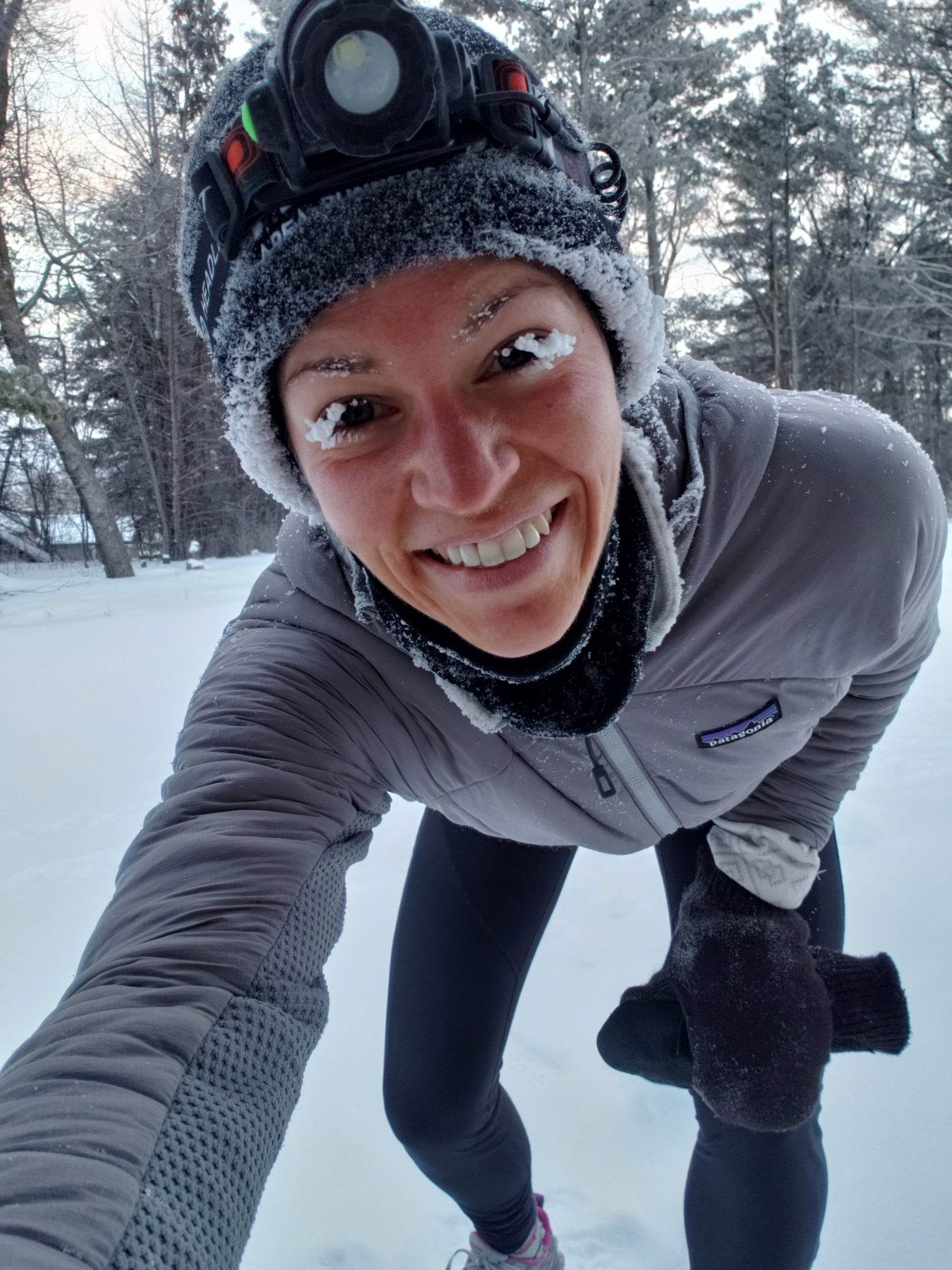
Winter running has helped me stay consistent with my running and wellness. I started running through the winter at the end of 2016, my first full year of running. I wanted to continue to make progress after taking 45min off my half marathon in the summer; I wasn’t going to throw all that progress out the window and start all over in the spring. Winter after winter I continue to make big strides. Winter running has has helped me take my half marathon from a 2:29 to a 1:24 and run my first half marathon in 3:15, qualifying for Boston.
How do you do it!? Don’t you freeze? You run on the treadmill, right?
Yes, I am one of those crazy Minnesotans that runs outside NO MATTER WHAT (although no shame if you don’t). My coldest run so far is in a wind-chill of -48 degrees Fahrenheit.
I run outside, year-round, because I love the outdoors! There is something magical about the quietness of an early morning run. I love the quiet, dark, clear mornings and the crispness of the air. It’s refreshing. The snow and cold air adds another level of peacefulness. And it builds mental toughness that transfers to the training cycle and LIFE .
I’m here to give you all my tips, advice, gear suggestions and tough love about cold weather running! I hope that you learn to love it (or at least learn to hate it less) and embrace the season of winter! There is so much beauty in it.
Whatever your intentions are for cold weather running, there are 4 key principles that apply to EVERYONE:
Mindset is KEY
Warm-up FIRST
Dress in layers that aren’t too tight
Remove ALL expectations (including pace) & have FUN – unleash your inner child!
🚨 PRs come from CONSISTENCY in the WINTER 🚨
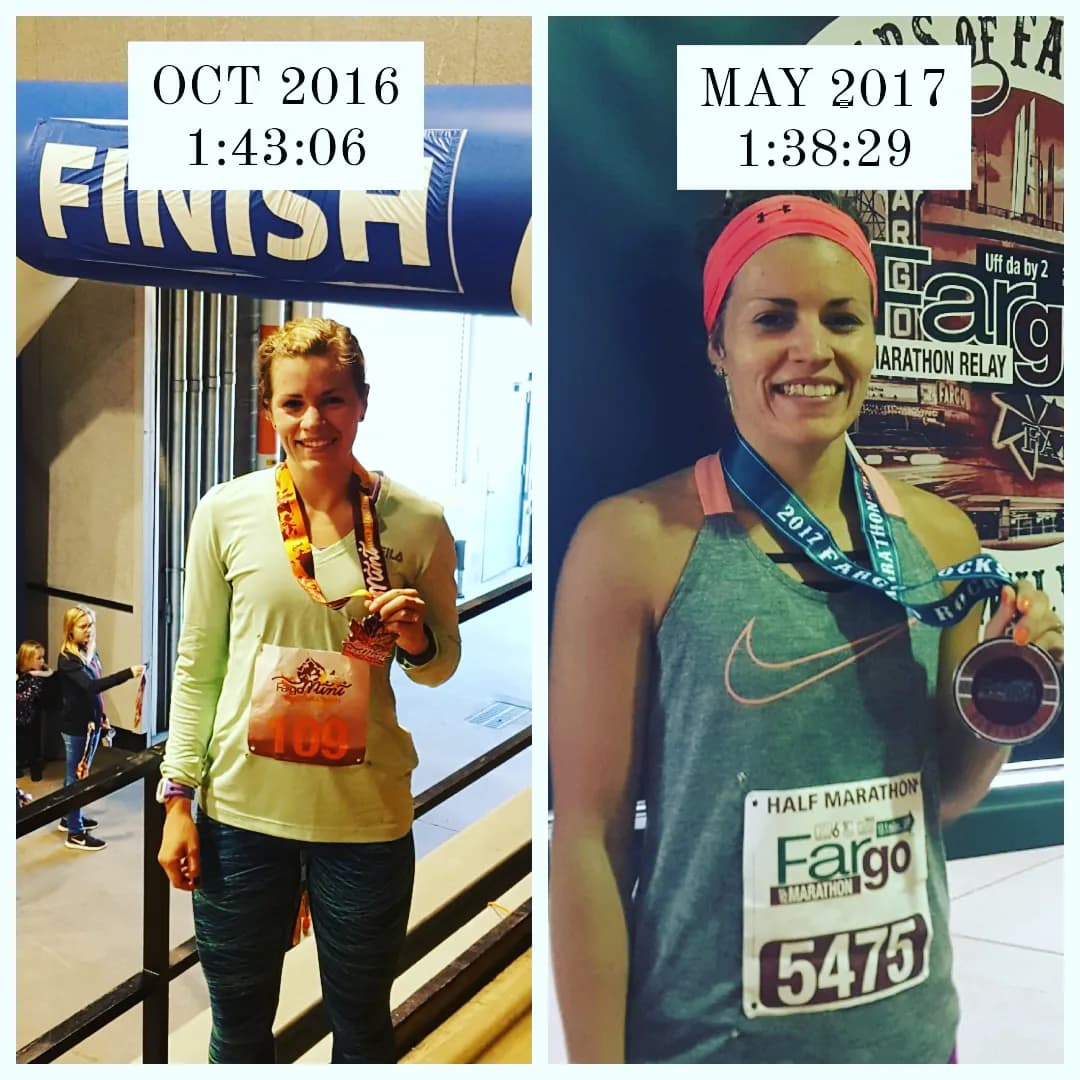
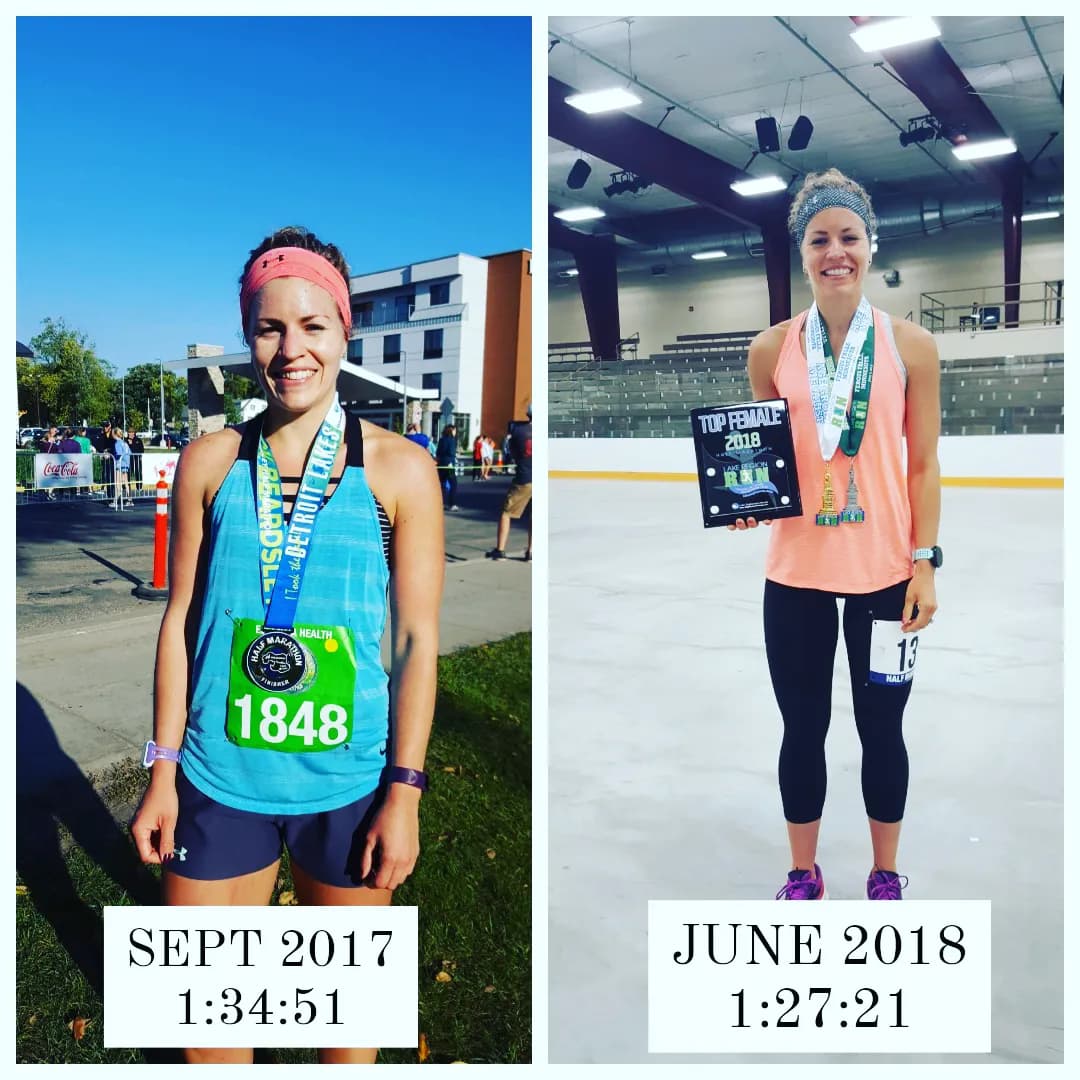
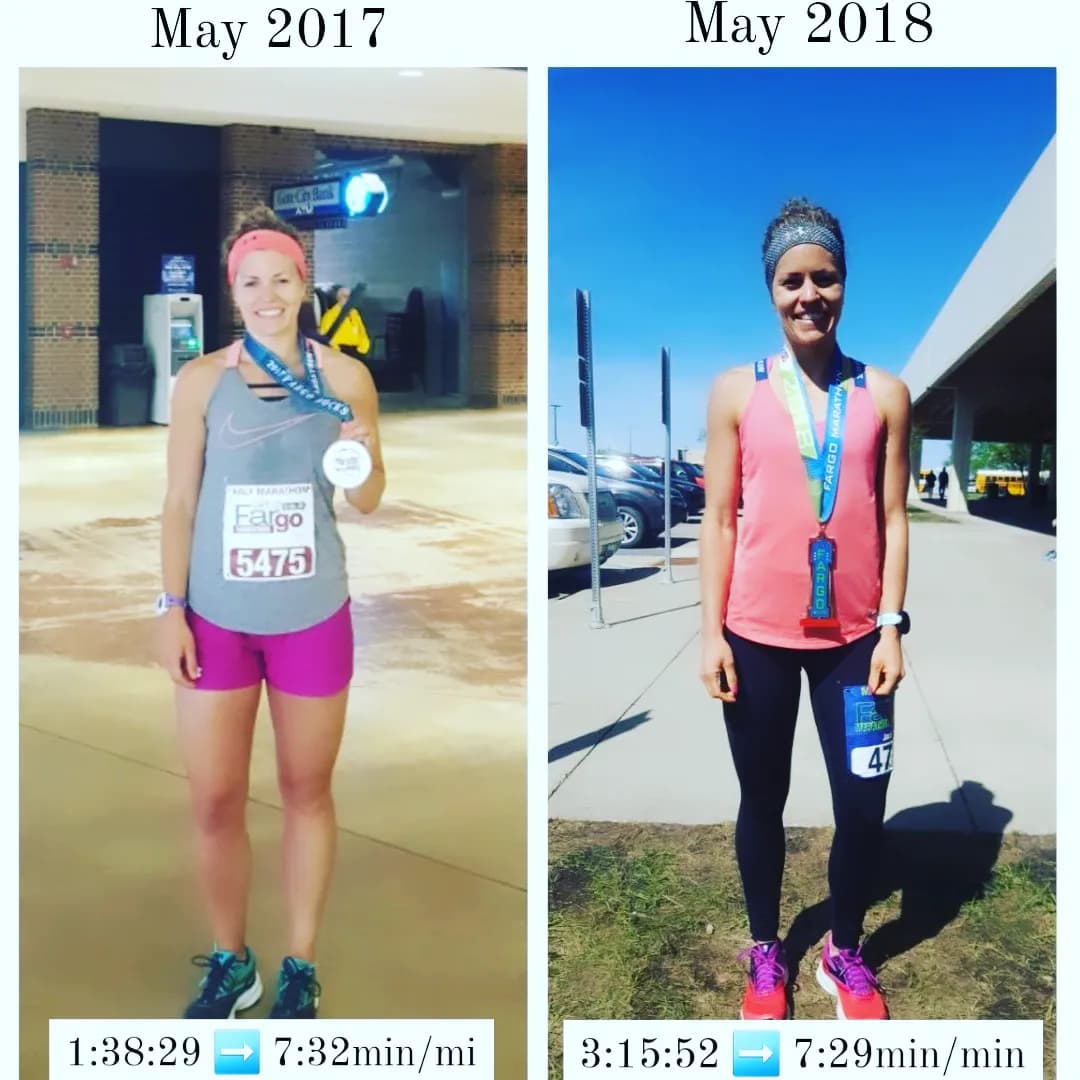
My first successful year of running was when I kept running and strength training and fueling my body consistently through the winter.
I didn’t stop and restart in the spring. I kept the momentum and progress from the prior year to continue making progress for the spring.
AND my biggest PRs have come in the spring from the prior fall after a winter of building endurance and strength and continuing to fuel my body and mind.
➡️ In 2016 I ran my first half in May in 2:29. After making big changes to my nutrition I ran a 1:43 in the fall.
➡️ I wanted to keep the momentum and progress I had made so I was consistent through the winter.
➡️ In May 2017 I ran a 1:38 and then chipped away at that time, running 3 other half marathons that year in the 1:30s.
➡️ I ran through the winter and ran my first marathon in May 2018 in 3:15. Less than a month later I ran a half in 1:27. I ran 3 other half marathons that year between 1:27 and 1:25.
➡️ AGAIN I was consistent through the winter, ran a marathon PR in May 2019 in 3:09 and ran 4 half marathons between 1:26 and 1:24, finally breaking sub 1:25.
Are you ready to be consistent through the off-season and make gains BEFORE your training cycle? Maybe you are tired of starting over each year? OR maybe you are ready to embrace cold weather running for what it is?
HERE ARE YOUR COLD WEATHER RUNNING TIPS
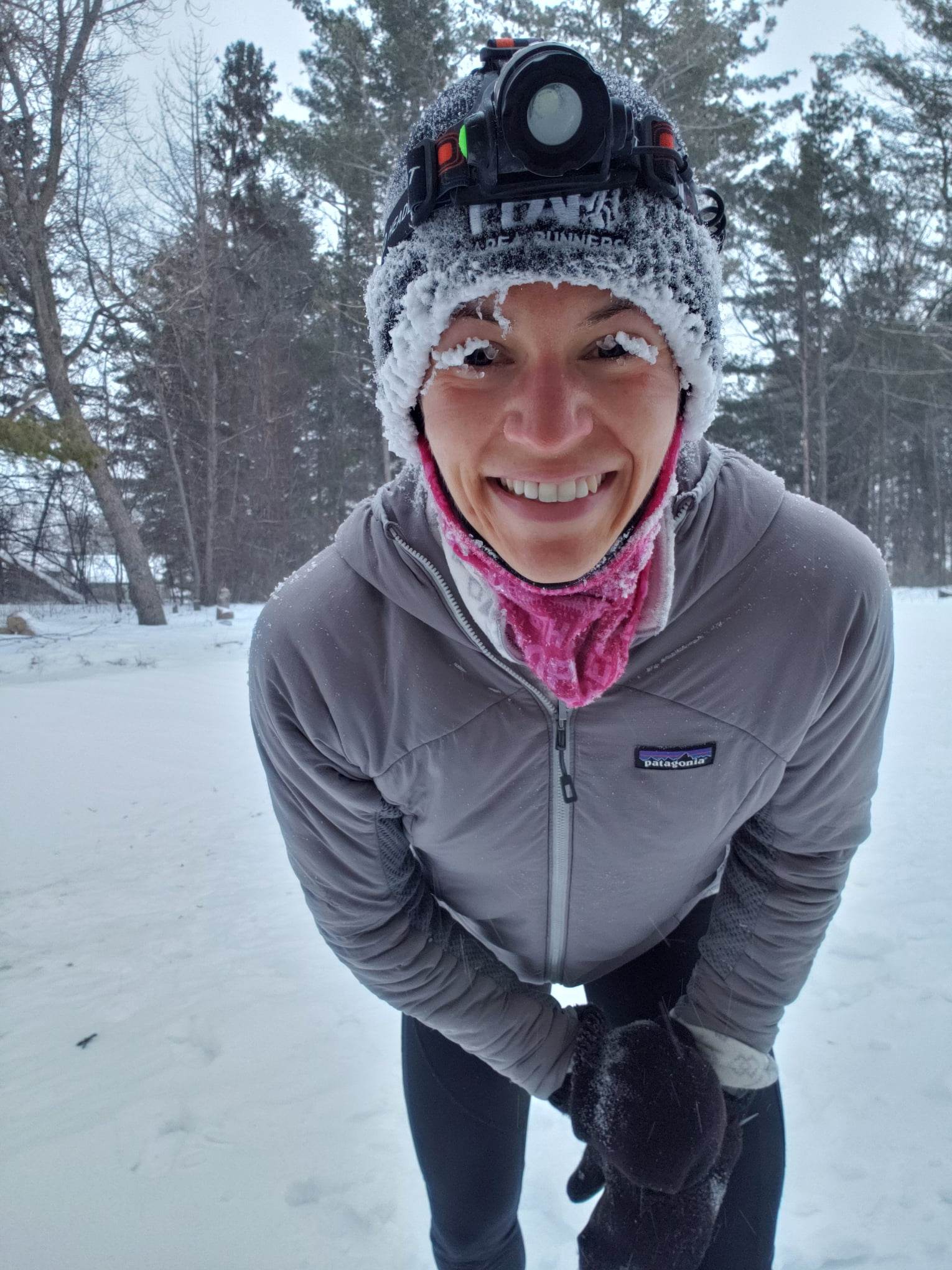
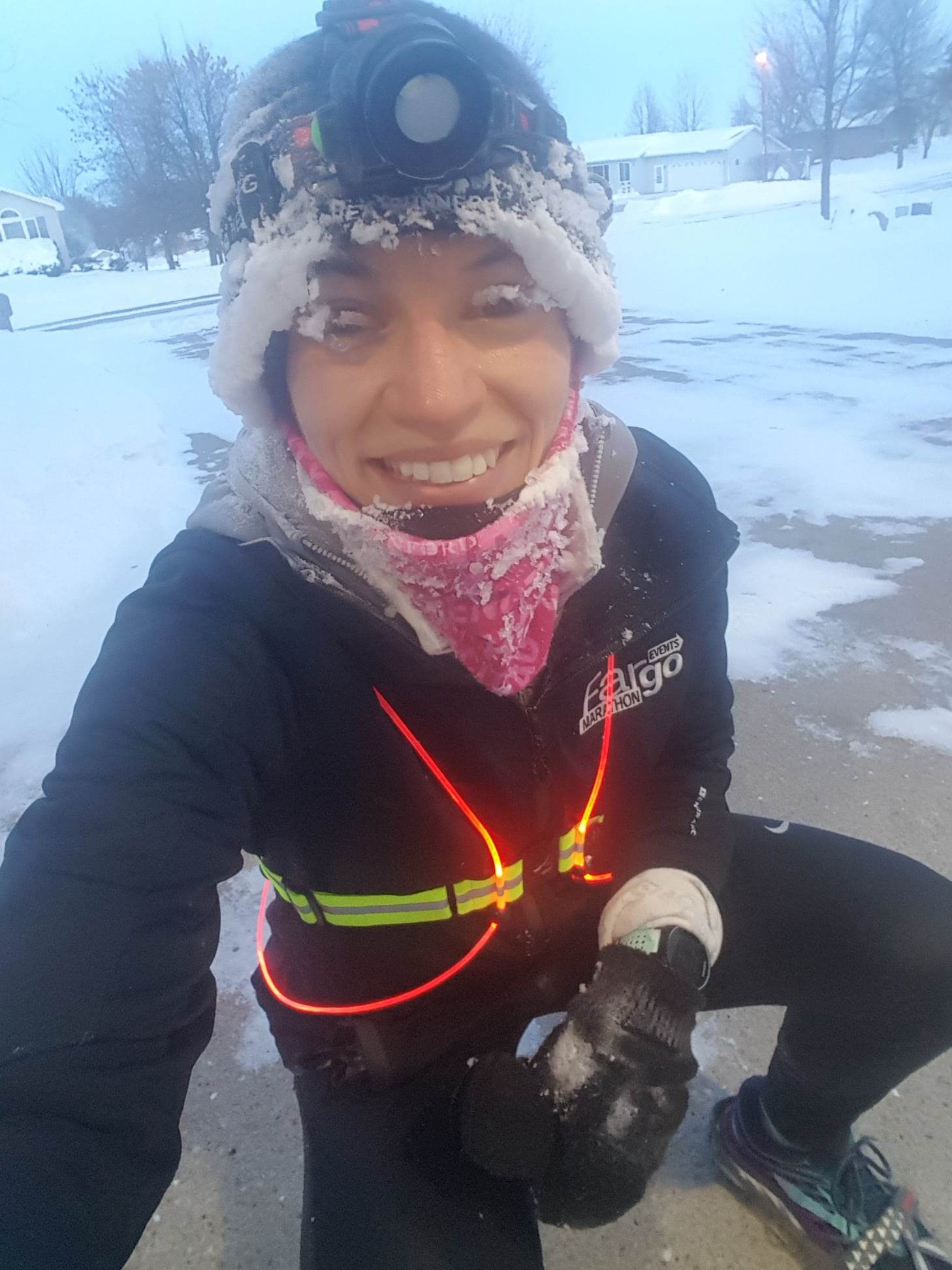
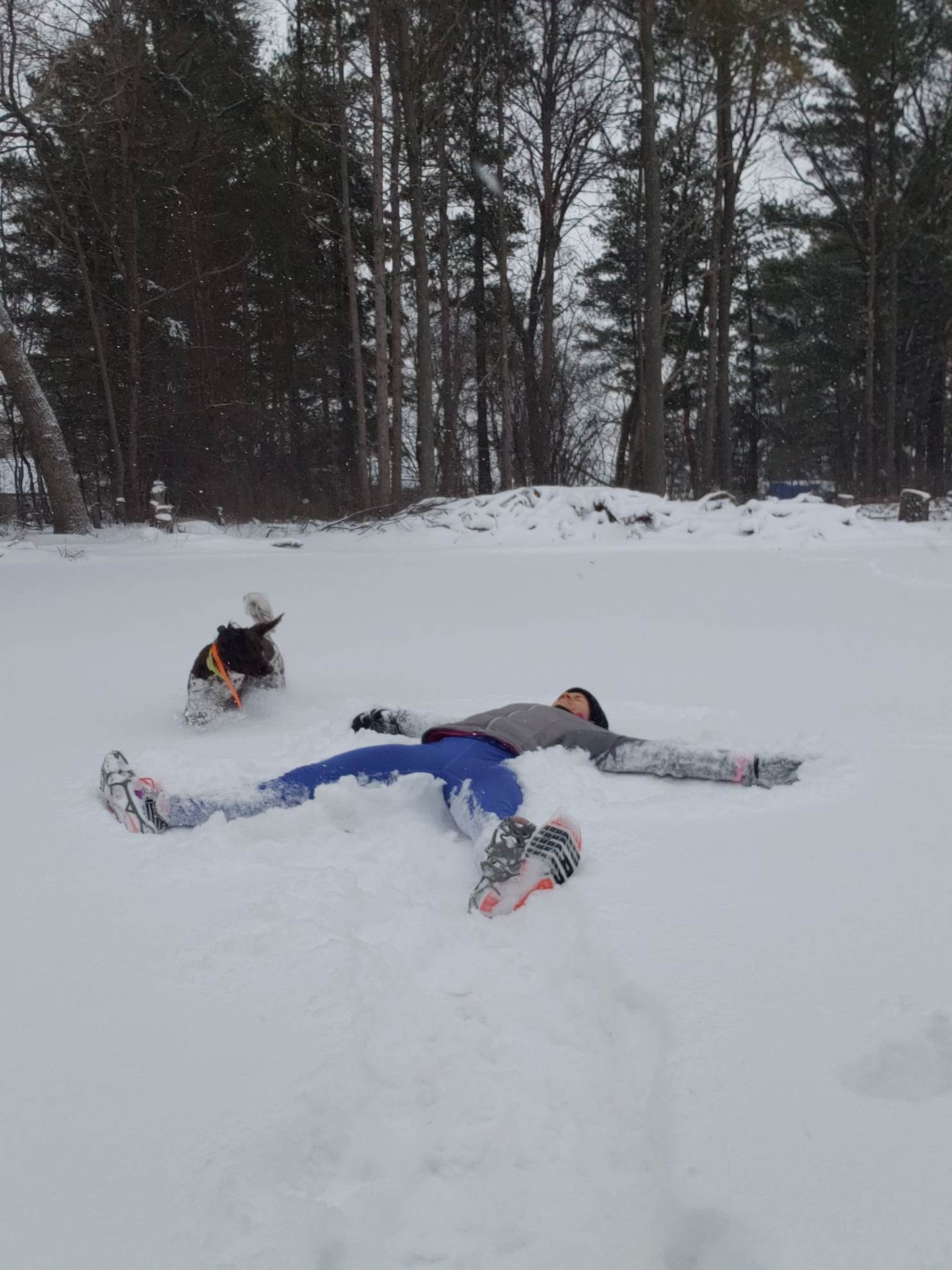
4 PRINCIPLES
OF COLD WEATHER RUNNING
1. Mindset is KEY
You CHOOSE to run. Maybe you are training for a race, building mileage or speed in the off-season, and working towards goals, but ultimately running is a choice! Accept the fact that winter is winter. You can’t pick the seasons and you can’t change the weather. Focus on what you CAN control. Remove all expectations and set the intention to have fun. Go into it with a positive attitude and remember that it could be much worse – it could be -60, white out conditions with roads of pure ice. You will have a great run. Don’t think about the temperature or the wind. Just get dressed, warm-up, and start running as soon as you open the door!
2. Warm-up FIRST
It’s one of the reasons I lift before I run (the first reason being for strength gains) – my body is warmed up so the shock of the cold is less! You’ll find you won’t over-dress AND you’ll actually start warmer and stay warmer while running. Here’s a 5-10min warm-up that you can do before you run. If you plan to do running drills, I suggest doing them inside.
3. Dress in layers
Layers layers layers! Have lots of options. A 10 F wind-chill because of a 2mph or because of a 30mph wind makes a HUGE difference! See discussions below on layering, but in general your base layer should be sweat-wicking, your middle layer should be for warmth and your top layer should be wind-blocking (if 3 layers is necessary for your conditions). I find that ice climbing brands, cycling brands and outdoor brands are better for the wind, snow and cold than typical running brands. Make sure your layers aren’t to tight – pockets of air are good because they hold warm air, and remember, warming up first will help prevent over-dressing.
The MOST IMPORTANT THING ABOUT GEAR is EVERYONE IS DIFFERENT. You have to figure out what is best for you. I have suggestions and brands listed below but ultimately you need to keep a weather & gear log – write down the temp, wind-chill, wind speed and what you wore. After your run, write down what worked, what didn’t, what got cold, what stayed warm, and what you will change for next time. It will get easier the more you do it.
4. Remove ALL expectations (including pace)
And have FUN – unleash your inner child! Plan a snowy run with a friend! You can either plan around the weather OR you can embrace it and plan to run on a day with BIG snowflakes, 6 inches of snow or crazy runs. Remember that pace doesn’t matter – winter running is focused on effort and time on your feet, and running in the snow and on ice is A LOT of work. 6 miles will probably feel like 10. Focus on time and HAVE FUN.
Download the Free Guide for
“Everything Cold Weather Running”

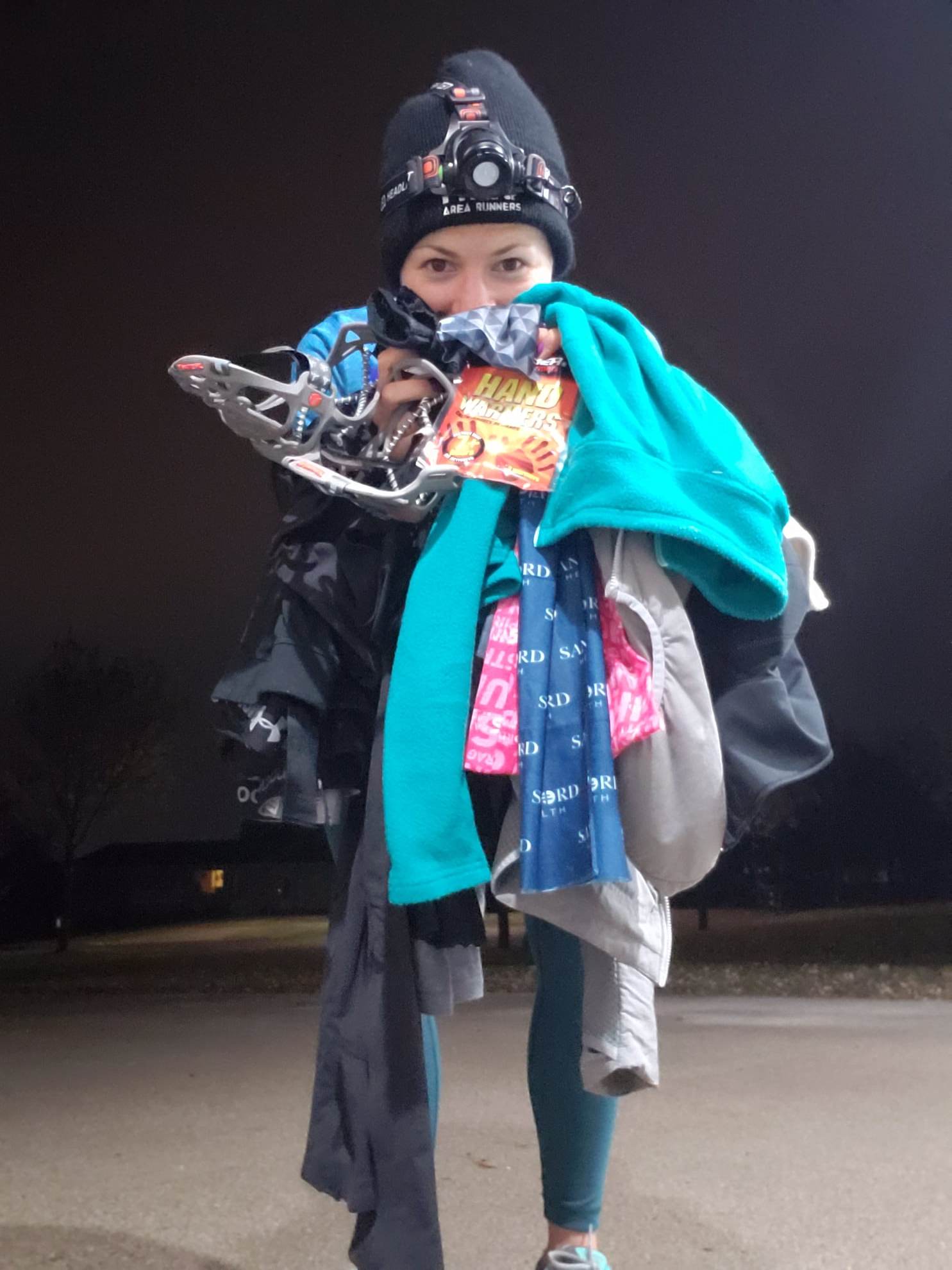
HOW DO I KNOW WHAT TO WEAR?
But first, MINDSET (yes, again). If you complain about how cold it is, that’s all you are going to think about. Running is a CHOICE! You need to stay positive. You GET to run. It could be worse – it could be the -60 F wind-chills that we had in January 2019 and 2021! You will have a great run. Don’t think about the temperature or the wind. Just warm up, get dressed and start running as soon as you open the door!
Below is how I decide what I will wear knowing I’ll be warming up beforehand – this is KEY. As I mentioned before, I always lift before I run. Not only do I believe that should you lift before you run so that you can maximize your strength, but working out beforehand warms up your body so you don’t experience the shock of the cold when you step outside.
- Check the temperature, wind speed and direction, and the wind-chill before you head outside. I think the wind-chill and the wind speed are the most important. The wind-chill gives me an idea of what layers I should put on, and the wind speed tells me if I need to wear my wind-breaking jacket and pants or not. TRACK THIS. Write down the weather stats, what you wore and what you would do differently next time with the same conditions to be more comfortable.
- Dress in layers! Make sure you have plenty of clothing options! I have multiple pairs of leggings and tops of different thicknesses and materials; tall socks to cover your ankles are a must; two thicknesses of mittens to choose from depending on the wind and temp; a nice thick hat, an earband, and various facemasks. And don’t forget to use handwarmers in those extreme temps! I use handwarmers on days when the wind-chill was colder than 20 F below zero.
- Check the footing! Is it snowy? Is it icy? Depending on the conditions, I may wear my trail shoes or my studded shoes (I use IceSpike) or Yaktrax. I wear my trail shoes when there is a dusting of snow or if the snow has already been packed down by traffic. I wear my studded shoes when the roads are icy or when there is a considerable amount of snow and/or there is ice underneath.
10 ESSENTIALS OF WINTER RUNNING LAYERING >
BUYING GEAR for WINTER RUNNING
You should always have lots of options. I’m not going to give you some chart that says wear X when it’s 0 F, and Z when it’s -20 F. You have to PRACTICE your layering because everyone is different and everyone FEELS cold differently. It’s a trial and error process.
DON’T go the cheap route. Running in the cold can be dangerous, especially if you aren’t dressed properly. Quality gear costs more but it’s worth your life. Test out your gear on shorter runs or run loops close to home. Remember that you can’t rely on your cell phone – it will shut off when it gets too cold.
And remember, warming up beforehand will help you TREMENDOUSLY; so will your mindset.
Below is what I wear, but YOU need to figure out what works for you. Track the weather, track what you wear and track if you were hot, cold or just right. Then adjust your next run. Pretty soon you’ll have a good idea of what YOU need. (order is from base layer to outer layer):
- Bottoms – Regular leggings (Lululemon Speed Up or Wunder Under HR 7/8, UnderArmour Cold Gear, Nike Shield (wind breaking material on quads)
- Tops – Base tank top or Lululemon Swiftly Tech Long Sleeve Crew; North Face ¼ zip fleece (2 different thicknesses); Patagonia Nano-Air Light Hybrid Hoody or RAB Cirrus Flex Jacket / Cirrus 2.0 Hoody (my new favorite), OGIO Endurance (breaks the wind, I wear when -40 F)
- Head – Asics earband, Carhartt hat
- Neck/Face – Saucony Drylete Neckwarmer, all purpose neckwarmer/gaiter/balaclava
- Hands – Saucony mittens (sometimes I hold onto a Kleenex in each mitten), handwarmers if the wind-chill is 10 F BELOW or colder
- Feet – Stance Run, Stance Run Crew/Wool Crew (always put on new dry socks after my workout)
- Safety – Noxgear Tracer 2, Cobiz LED Headlamp, IceSpike screws for shoes, Yaktrax
OTHER DRESSING & GEAR TIPS THAT NO ONE TELLS YOU
Tuck your shirt into your pants. It traps in heat and the wind won’t go up your shirt.
If your hands and/or feet are cold you don’t have enough clothing on your core. Keep your core warm and the rest of your body will stay warm.
Mittens over gloves. Mittens keep your fingers together which means more warmth. Gortex mittens are highly recommended. Use handwarmers when needed. But again, focus on your core
Cover your nose and mouth. This keeps heat in from breathing. Make sure your cover is loose/has form – if it is tight around your face you will feel suffocated.
Your outer layer should be both waterproof and wind-breaking. Both will keep you warmer.
Add salt and maple syrup to your water bottle to slow down the freezing of your hydration.
Keep your ankles covered otherwise they will crack from the dry air and cold.
Make sure your layers aren’t too tight. Pockets of air hold heat.
You can’t rely on your phone. Once it gets to a certain temp (too cold) it will shut off until it warms up again.
Remember that your heart-rate is going to be higher than usual when your nose and mouth are covered. Slow down – focus on time on your feet! Check out this reel.
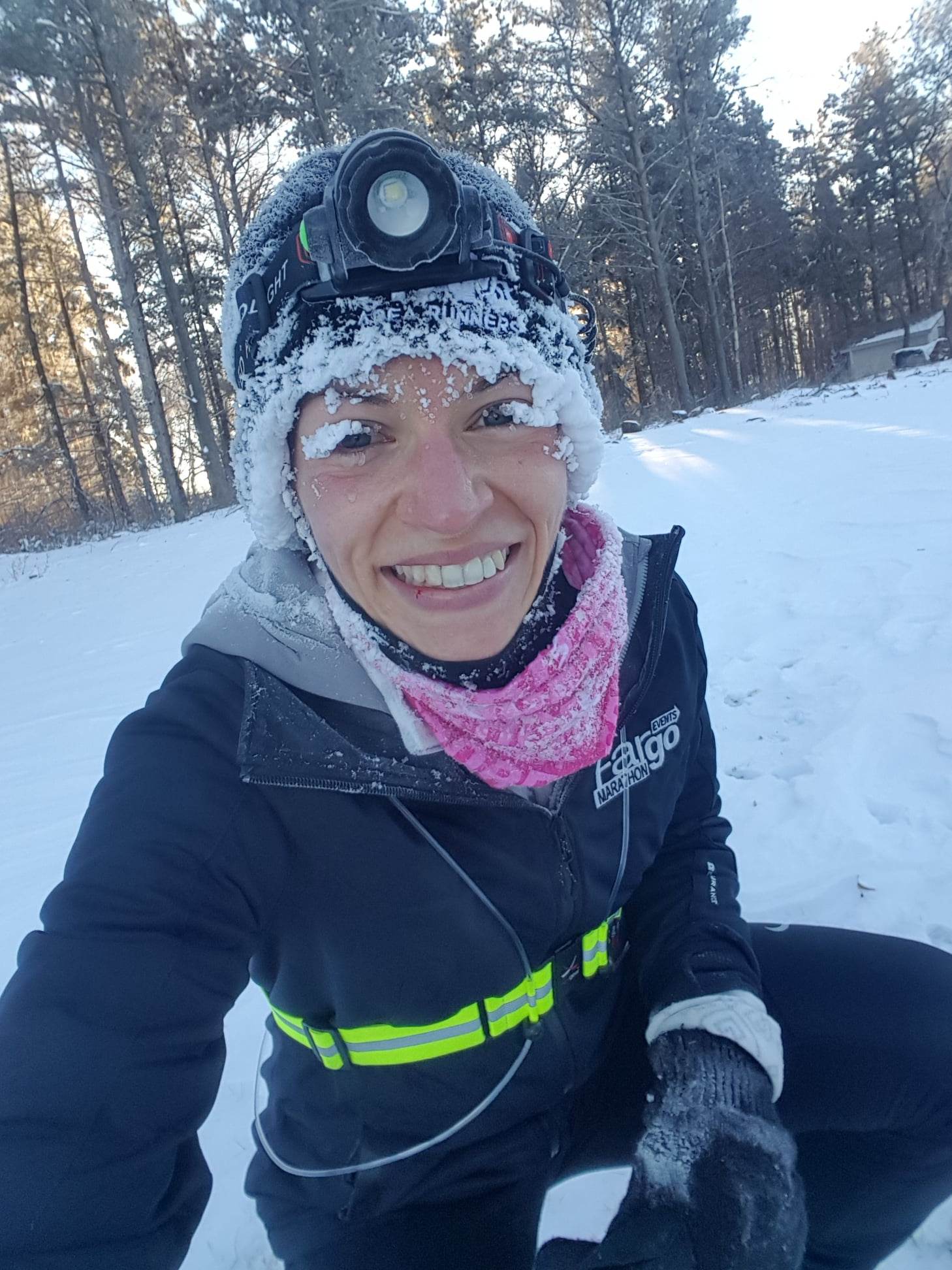
Winter running questions and gear suggestions!
Accept it. You can’t change the seasons.
Plan around the weather.
Set the expectation to have fun.
Plan a snowy run with a friend.
- Warm up before you run (I lift before I run)
- Wear layers and keep your core warm – your core is key!
- Have different options of mittens or gloves (I always wear mittens)
- Resort to handwarmers or electric mittens (for me that means a wind chill of -10 or colder)
Check out this YouTube video that I created – you can install your spikes along with me!
- Run with a friend so you have to leave at X time to leave them
- Don’t think about the wind – it sounds worse than it really is
- Warm up beforehand – it will lessen the shock of the cold and prevent overdressing
- Think about how you will feel after your run
- Count down from 5 and JUST DO IT!
- Focus on form! This is most important – whether it is super cold or it is snowy or icy, form is most important.
- Warm up before you go outside – get your body and legs moving
- Do glute activation exercises beforehand so your glutes are ready to fire – the force of your run comes from your hips, glutes and hamstrings
- Don’t forget about your arms! They will help you a ton.
- Wear trail shoes or ice cleats to get better traction unless you have completely dry pavement
- Wear a headlamp if you are running in the dark (even if you normally don’t). You are running faster than usual and you will have less time to react to a bump, crack, or object on the road
- Be OKAY with your pace being slower than usual – it is cold, snowy, or icy, and it is about EFFORT in the winter. Winter running brings spring PRs!
You can focus on speed or building mileage/your aerobic capacity in the winter. If you don’t run on the treadmill and you have snow and ice like me, I suggest working on building mileage. If you are just coming off marathon training OR you will be marathon training, and you have access to a treadmill, building speed NOW will help tremendously leading into your training cycle.
HOWEVER, remember the off-season is NOT just about running. Everyone can focus on ALL THE THINGS in between training cycles. Building strength through strength training and mobility work is crucial to staying injury free, improving running economy, and building strength and speed in your runs. Focusing on adequate rest and sleep, as well as working on your mindset and nutrition will help you be READY for ramping up for your training cycle. Then you’ll just have to tweak things as your training cycle progresses.
Track the weather and what you wear! Either put pencil to paper or use an excel spreadsheet. Track the temperature, wind speed, wind-chill, precipitation and road conditions. Also track what you wear. When you get back from your run take notes. What got cold? Were you too warm? What would you do differently next time? The more often you do this the easier it will get. AND your journal will make it easier next winter when you try to figure out what to wear.
Just remember that everyone is different so what you wear may not be enough for others OR it may be too much.
Besides the tips we have already talked about (warm-up and dress in layers), plan your route ahead of time. Running close to home or running a loop is a good idea when the weather is extreme. Remember that you can’t rely on your phone – it will shut off when it gets too cold, even if you think it is close enough to your body. Tell someone where you are running and how long you plan to be out. Know your route – where is shelter? Where are stores that will be open? Is it quicker to turn around from where you came from or keep going? The colder the run, the more important it is to know these safety measures.
Here is a similar headlamp to the one I have. My smaller headlamp dims really fast once temps drop below freezing – regular batteries will freeze. This headlamp is rechargeable and super bright – I’ve never had problems with it dimming!
SO WHAT IF I WANT TO MAKE GAINS IN THE OFF-SEASON?
I’VE GOT YOU THERE TOO! OFF-SEASON WORK IS ONE OF MY FAVORITES!
Imagine what your 2023 races, goals and accomplishments would look like if you committed to being consistent in the off-season! Are you ready to commit to putting in the work in the off-season (aka when you aren’t training)?
IMAGINE yourself STARTING a training cycle feeling strong and injury free, with an abundance of energy from good nutrition. You are EXCITED to start training for your BIG scary goal, but instead of questioning yourself and letting doubt creep in about whether or not you can hit that goal or get through the training cycle without feeling burnt out or getting injured, you are ready to ATTACK every workout and long run because you KNOW you can put in the work to CRUSH your goal. The goal gives you butterflies BUT it doesn’t frighten you.
THAT’S the power of off-season training. It sets you up for success and it gets you excited for the next training cycle/goal.
Why train in the off-season?
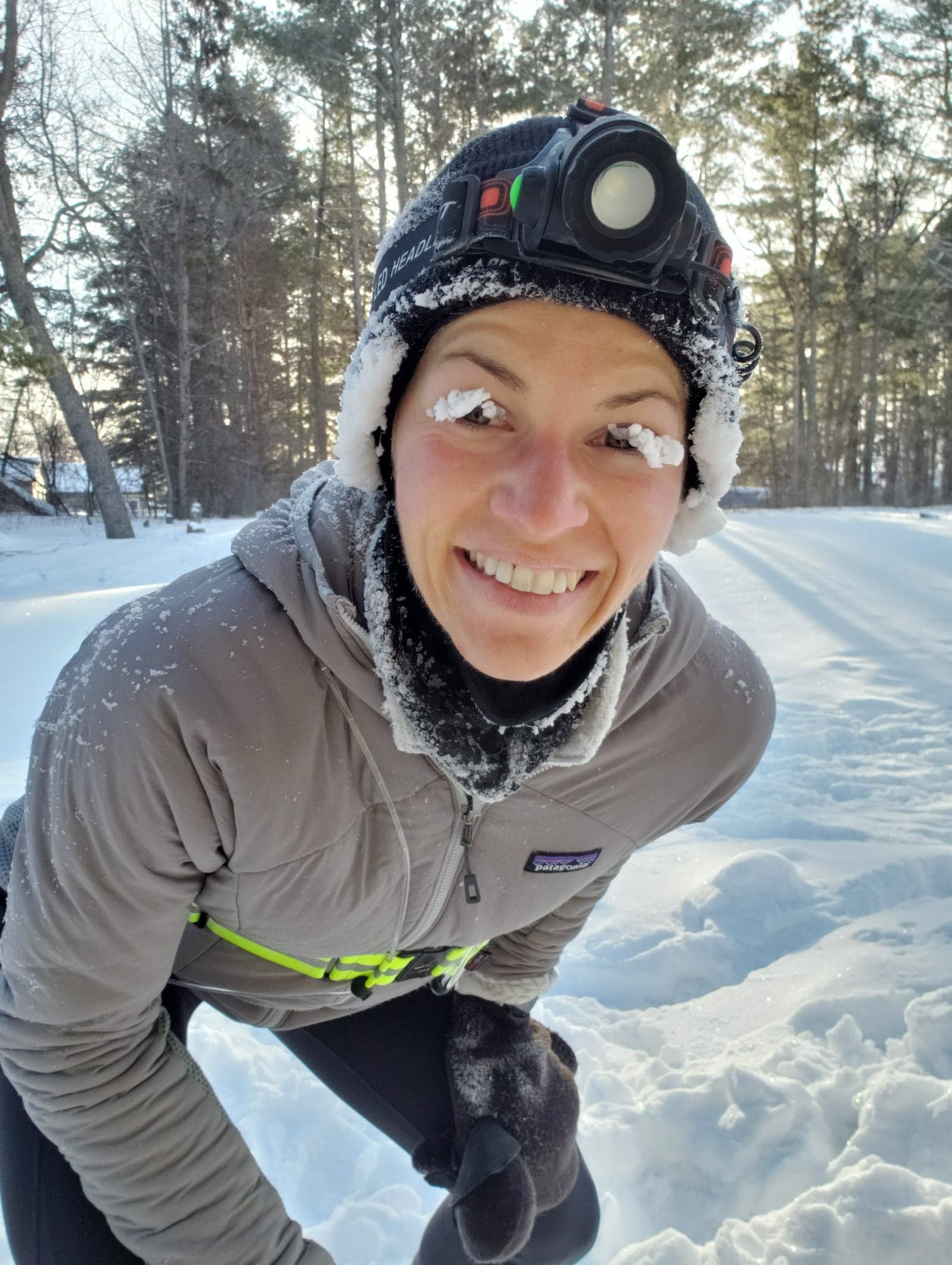
Follow a plan instead of doing random workouts/runs with no purpose, “thinking” you know what you need
Reduce decision fatigue by following a plan
Have support through the mundane of the off-season
Incorporate variety into your training that has PURPOSE so you don’t get bored
Make sure you aren’t doing too much that results in burnout
Eliminates having to “start-over” with running/mileage when gearing up for your next training cycle
Keeps the fun and joy in running OR can help you find the joy in running again
Allows you to spend time doing things that were put on the backburner during training WHILE maintaining fitness
READY TO COMMIT TO THE OFF-SEASON AND BE CONSISENT? >
BUT REMEMBER, THE OFF-SEASON ISN’T ABOUT NOT RUNNING
It’s about reconnecting with your love for running, promoting recovery, reflecting on your past performances and what goals you want to strive for next, continuing to run (lower mileage than a training cycle) so you don’t have to “start over” when gearing up for a training cycle, AND most importantly, working on “ALL THE THINGS” (strength training, nutrition, sleep, mobility, mindset, running form/technique, etc.) that will benefit your running (mentally, physically and emotionally) when you start getting ready for your next training cycle.
RUNNING GOALS AND PRS ARE NOT MADE IN THE COUPLE MONTHS LEADING UP TO YOUR RACE
They START in the off-season. Getting stronger and faster, becoming a smarter runner, and being more mentally fit is the accumulation of months upon months of consistent training leading up to your training cycle.
HOWEVER, the off-season CAN get mundane or boring… OR you may be burnt out from running after completing your last race.
That’s why having a plan for the off-season is SO important!
If you have big running goals for 2023, NOW is the time to start working on them.
But you may be like, wait, Coach Jaci, what about rest? I’m exhausted. I need to rest.
YES, rest is crucial! Rest is part of the off-season! Off-season training is NOT high mileage marathon training. Off-season training is working on areas that need more focus like sleep, strength training, mobility and nutrition. You CAN make significant gains during the off-season to set yourself up for a successful training cycle before you next race/goal!
Every runner is unique, and every runner has different goals, which means every runner’s off-season is DIFFERENT – Every plan is tailored to the runner.
Download the Free Guide for
“4 Things to Start Doing NOW Before and After Your Runs”
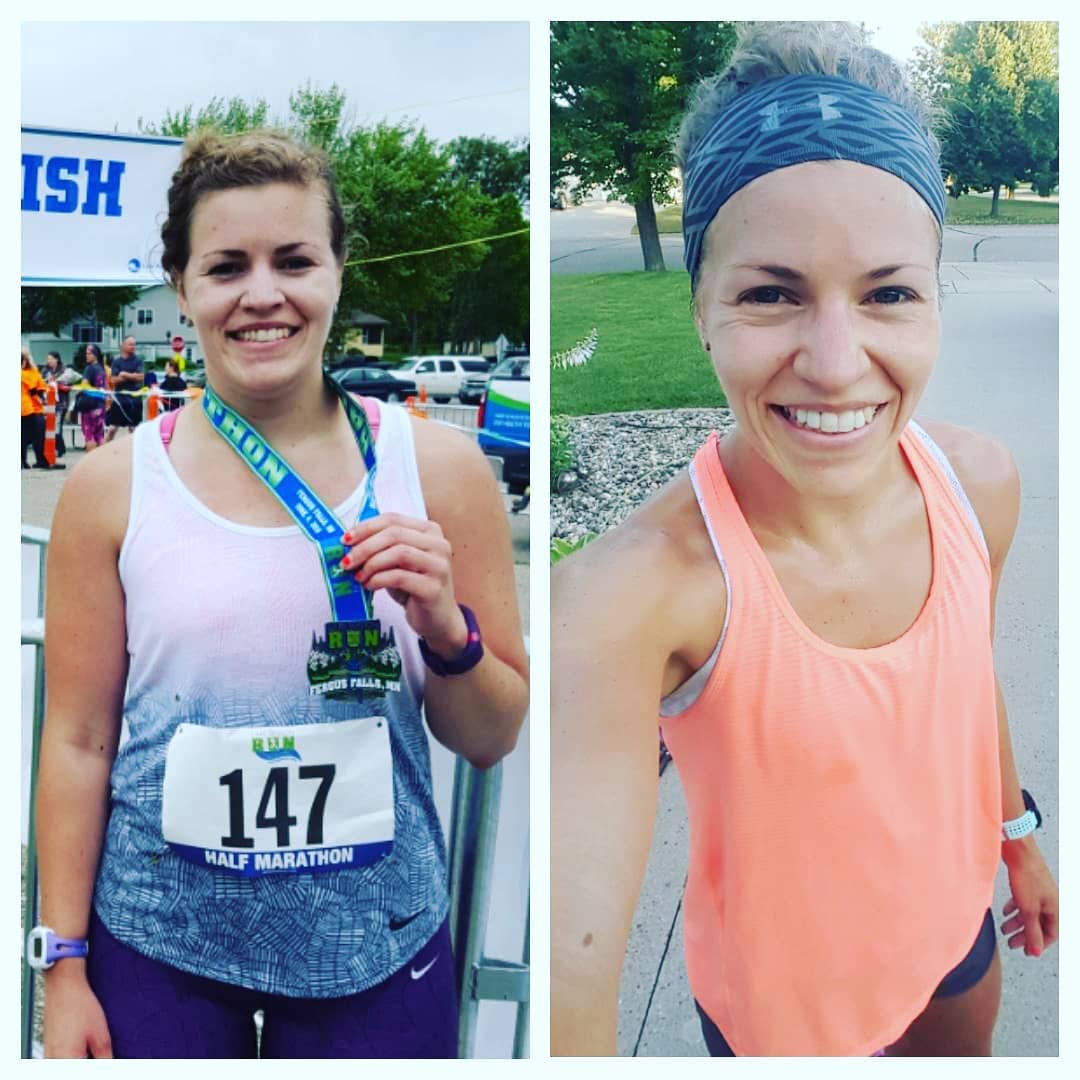
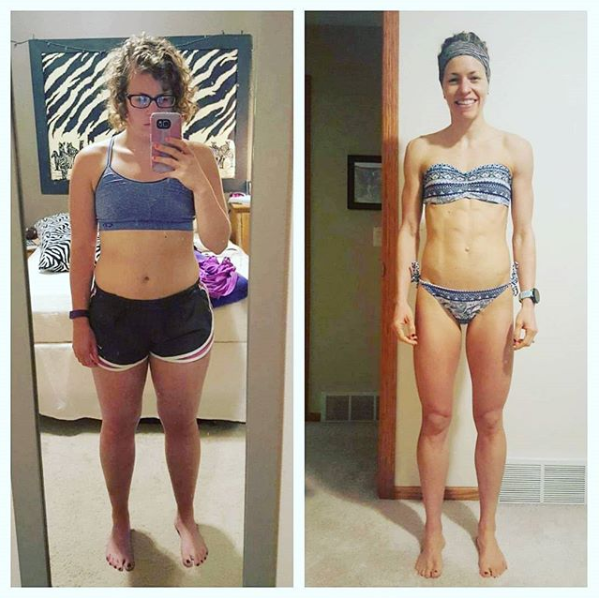
my story
MY TRANSFORMATION
I haven’t always been a runner. I haven’t always been fast. I haven’t always been lean.
I took up running 6 years ago because I wanted to lose weight. I thought running was the answer. Turns out it isn’t. Running does NOTHING for weight loss – at least not for me. It just makes me HUNGRIER! So then, I thought I should eat less, especially carbs. I wasn’t seeing any results so I went back to eating carbs and counting calories on and off. I would lose and gain the same 5lbs and wasn’t getting any better at running.
The secret? You have to do the work!
- I cleaned up my nutrition
- I started eating MORE
- I focused on QUALITY of food
- I changed my MINDSET about food
- I started FUELING my body for PERFORMANCE
- I implemented STRENGTH TRAINING for runners
- I focused on SELF_CARE
- I stretched and foam rolled
- I SLEPT
- I started EATING TO RUN
I focused on what I COULD CONTROL! I did ALL THE THINGS! The little things are BIG THINGS!
The most important thing? NUTRITION!
That’s when the changes started happening. That’s when I started seeing results. I changed my mindset and prioritized NUTRITION. I felt the ENERGY that it gave me. And I still do! I feel absolutely AMAZING!
BUT please note that knowledge is NOT power. APPLIED knowledge IS power! You can know EVERYTHING there is to know, but if you do not apply it, it does you no good. You actually have to DO THE WORK.
And that’s what I’m here to do – to hold you accountable and help you get results!
Stay Connected
follow my running journey
READY TO BECOME A STRONGER, FASTER RUNNER WITHOUT MAKING RUNNING A FULL-TIME JOB?
SIGN UP TO GRAB YOUR FREEBIE – 10 THINGS YOU CAN DO TODAY TO BECOME A STRONGER, FASTER RUNNER

